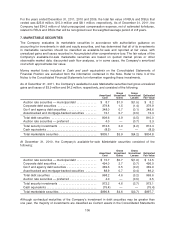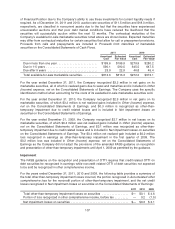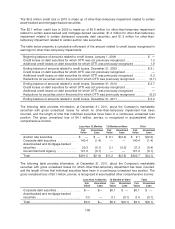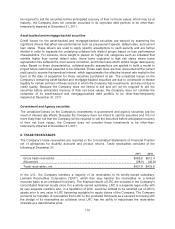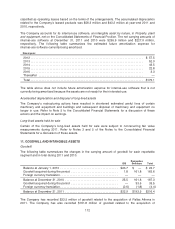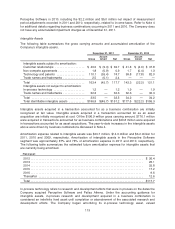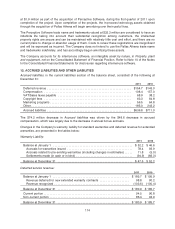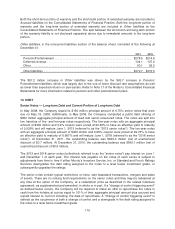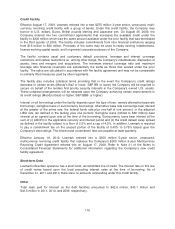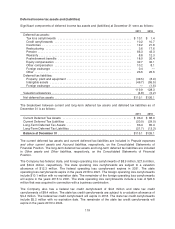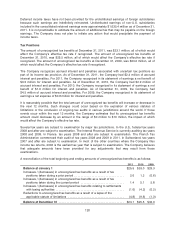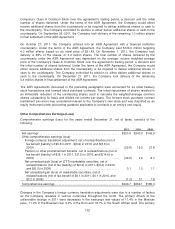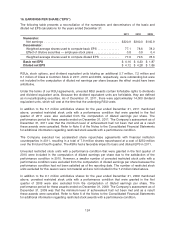Lexmark 2011 Annual Report Download - page 119
Download and view the complete annual report
Please find page 119 of the 2011 Lexmark annual report below. You can navigate through the pages in the report by either clicking on the pages listed below, or by using the keyword search tool below to find specific information within the annual report.
Both the short-term portion of warranty and the short-term portion of extended warranty are included in
Accrued liabilities on the Consolidated Statements of Financial Position. Both the long-term portion of
warranty and the long-term portion of extended warranty are included in Other liabilities on the
Consolidated Statements of Financial Position. The split between the short-term and long-term portion
of the warranty liability is not disclosed separately above due to immaterial amounts in the long-term
portion.
Other liabilities, in the noncurrent liabilities section of the balance sheet, consisted of the following at
December 31:
2011 2010
Pension/Postretirement ................................................. $278.5 $214.8
Deferred revenue ...................................................... 104.1 107.2
Other ................................................................ 90.1 93.5
Other liabilities ........................................................ $472.7 $415.5
The $57.2 million increase in Other liabilities was driven by the $63.7 increase in Pension/
Postretirement liabilities, which was largely due to the use of lower discount rate assumptions as well
as lower than expected returns on plan assets. Refer to Note 17 of the Notes to Consolidated Financial
Statements for more information related to pension and other postretirement plans.
13. DEBT
Senior Notes — Long-term Debt and Current Portion of Long-term Debt
In May 2008, the Company repaid its $150 million principal amount of 6.75% senior notes that were
due on May 15, 2008. Additionally, in May 2008, the Company completed a public debt offering of
$650 million aggregate principal amount of fixed rate senior unsecured notes. The notes are split into
two tranches of five- and ten-year notes respectively. The five-year notes with an aggregate principal
amount of $350 million and 5.9% coupon were priced at 99.83% to have an effective yield to maturity
of 5.939% and will mature June 1, 2013 (referred to as the “2013 senior notes”). The ten-year notes
with an aggregate principal amount of $300 million and 6.65% coupon were priced at 99.73% to have
an effective yield to maturity of 6.687% and will mature June 1, 2018 (referred to as the “2018 senior
notes”). At December 31, 2011, the outstanding balance was $649.3 million (net of unamortized
discount of $0.7 million). At December 31, 2010, the outstanding balance was $649.1 million (net of
unamortized discount of $0.9 million).
The 2013 and 2018 senior notes (collectively referred to as the “senior notes”) pay interest on June 1
and December 1 of each year. The interest rate payable on the notes of each series is subject to
adjustments from time to time if either Moody’s Investors Service, Inc. or Standard and Poor’s Ratings
Services downgrades the debt rating assigned to the notes to a level below investment grade, or
subsequently upgrades the ratings.
The senior notes contain typical restrictions on liens, sale leaseback transactions, mergers and sales
of assets. There are no sinking fund requirements on the senior notes and they may be redeemed at
any time at the option of the Company, at a redemption price as described in the related indenture
agreement, as supplemented and amended, in whole or in part. If a “change of control triggering event”
as defined below occurs, the Company will be required to make an offer to repurchase the notes in
cash from the holders at a price equal to 101% of their aggregate principal amount plus accrued and
unpaid interest to, but not including, the date of repurchase. A “change of control triggering event” is
defined as the occurrence of both a change of control and a downgrade in the debt rating assigned to
the notes to a level below investment grade.
115



